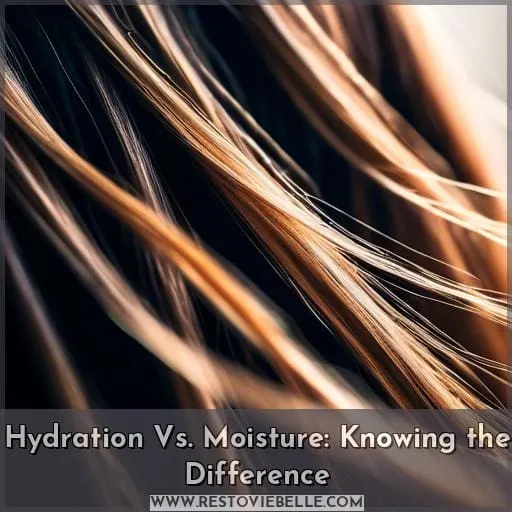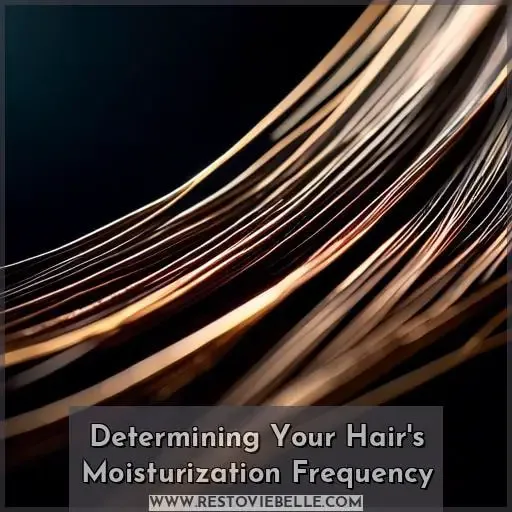This site is supported by our readers. We may earn a commission, at no cost to you, if you purchase through links.

You might wonder how often you should moisturize your hair to maintain its health and luster. The answer isn’t one-size-fits-all; it hinges on your hair’s unique characteristics and the environment you’re in.
Moisturizing your hair too frequently or too sparingly can lead to undernourishment or oversaturation, respectively.
This guide will delve into the nuances of hair hydration versus moisture, the factors that dictate your hair’s moisturizing needs, and how to select and apply the right products to keep your hair at its best.
Embrace the journey to mastering your hair’s moisture balance and unlock the secrets to soft, resilient, and healthy locks.
Yes, you should moisturize your hair regularly. The frequency varies, typically between every 3-7 days, depending on your hair’s needs and condition.
Table Of Contents
- Key Takeaways
- Understanding Hair Moisturization Needs
- Hydration Vs. Moisture: Knowing the Difference
- Determining Your Hair’s Moisturization Frequency
- Choosing the Right Moisturizing Products
- Application Techniques for Effective Moisturization
- Frequently Asked Questions (FAQs)
- How can I tell if my hair is over-moisturized and what should I do if it is?
- Are there specific ingredients in hair products I should avoid to prevent moisture loss?
- How does hard water affect hair moisture and what can I do to mitigate its effects?
- Can dietary changes impact the moisture levels of my hair?
- What are the best practices for moisturizing hair while swimming or engaging in water sports?
- Conclusion
Key Takeaways
- Moisturize your hair every 3-7 days, adjusting based on your hair’s needs and response to products.
- Use water-based products for hydration and oil-based products to seal in moisture, avoiding heavy silicones.
- Apply moisturizer evenly, focusing on ends and mid-lengths, and consider using a spray bottle for styles that you don’t want to disrupt.
- Deep condition at least once a month and adjust moisturizing frequency according to hair type, lifestyle, and environmental factors.
Understanding Hair Moisturization Needs
Balancing hair moisture is crucial; too much or too little can lead to issues like breakage or limpness.
You’ll need to watch for signs indicating your hair’s thirst for moisture, such as dryness or brittleness.
Recognizing the Importance of Not Over-moisturizing or Under-moisturizing Your Hair
Maintaining the right moisture balance in your hair is crucial for its health and appearance.
- Moisture Balance: Achieving the perfect moisture balance prevents your hair from becoming too brittle or too limp. Over-moisturizing can lead to weighed-down hair, while under-moisturizing can cause breakage and dryness.
- Protein Treatments: Incorporating protein treatments helps strengthen hair, especially if it’s chemically treated or damaged. Protein is vital for hair structure and health, complementing moisture to maintain hair integrity.
- Hair Porosity and Scalp Health: Understanding your hair’s porosity is key to determining how it absorbs and retains moisture. Proper moisturization supports scalp health and influences styling effects, ensuring your hair looks and feels its best.
By balancing moisture and protein, you can keep your hair resilient and vibrant, avoiding common pitfalls that compromise hair health.
Identifying Signs That Your Hair Needs Moisture
When you notice your hair exhibiting signs of dryness, breakage, frizz, dullness, or split ends, it’s a clear signal that it’s craving moisture.
Dry hair can appear lifeless and lack its natural sheen, feeling rough to the touch. If your strands are prone to frizz or your scalp feels itchy, these are indicators of moisture loss.
Breakage, often seen as short, broken hairs, or split ends, where the hair strand separates into two or more parts, also points to a need for hydration. Don’t ignore these signs; they’re your hair’s plea for a moisturizing intervention to restore its vitality and health.
Hydration Vs. Moisture: Knowing the Difference
Understanding the distinction between hydration and moisture is crucial for proper hair care.
Hydration involves adding water to your hair, which is essential for its internal health.
Moisturizing refers to sealing in that hydration to protect the hair’s outer layer.
To maintain your hair’s vitality, you should use water-based products for hydration and oil-based products to lock in moisture, ensuring a balanced approach to hair care.
Explaining the Concept of Hydration (adding Water) and How It Differs From Moisturizing (sealing in Hydration)
Understanding the balance between hydration and moisturizing is key to preventing both over and under-moisturization.
- Hydration combats trans-epidermal water loss by infusing your hair with water.
- Moisturizing with oil-based products seals in that hydration, using emollients to lock in moisture.
- Leave-in conditioners often combine humectants and emollients, catering to different hair porosity needs.
The Role of Water-based Products in Hydration and Oil-based Products in Moisture
Understanding the role of water-based and oil-based products in hair care is crucial for achieving optimal moisture balance. Water-based products are designed to hydrate your hair by adding water directly to your strands.
They’re particularly effective for penetrating the hair shaft, providing the hydration your hair desperately needs. On the other hand, oil-based products focus on sealing in that hydration, preventing moisture loss by creating a protective layer over your hair shaft.
To help you visualize the differences and applications of these products, consider the following table:
| Product Type | Primary Function | Best Used For |
|---|---|---|
| Water-based | Hydrating the hair | Adding moisture |
| Oil-based | Sealing in moisture | Retaining moisture |
| Humectants | Attracting moisture | Enhancing hydration |
| Emulsifiers | Combining oil and water | Formulating balanced products |
| Sealants | Locking in moisture | Final step in moisturizing |
Incorporating both water-based products for hydration and oil-based products for moisture retention is key. Humectants, like glycerin, play a significant role in attracting moisture from the environment, further enhancing hydration.
Emulsifiers ensure that oil and water-based ingredients can mix effectively, creating balanced hair care products. Lastly, sealants are crucial for locking in all the moisture your hair has absorbed, ensuring it stays hydrated longer.
Determining Your Hair’s Moisturization Frequency
Determining the right frequency for moisturizing your hair is a nuanced process that hinges on several factors, including your hair type, lifestyle, and the environment you’re in.
If you’re attentive to your hair’s condition and use high-quality products, you might find that moisturizing every 3-7 days is sufficient.
Adjust your routine based on how your hair responds to different moisturization frequencies, ensuring you strike the perfect balance for healthy, hydrated locks.
Factors Influencing How Often You Should Moisturize Your Hair, Including Hair Type, Lifestyle, and Environmental Conditions
Understanding how often to moisturize your hair is crucial, and several factors play into this decision. Your hair’s porosity is a key determinant; it affects how your strands absorb and retain moisture.
High porosity hair may need daily moisturizing to maintain balance, while low porosity hair might thrive with weekly deep conditioning treatments.
Your lifestyle, including daily activities and styling habits, also influences your hair’s moisture needs. Environmental conditions, such as humidity and temperature changes, can either rob your hair of moisture or contribute to its retention, necessitating adjustments to your moisturization frequency.
Paying attention to product absorption can help you tailor your routine, ensuring your hair remains hydrated without being weighed down or over-moisturized, which could lead to hygral fatigue.
Guidelines for Adjusting Moisturization Frequency Based on Personal Observations
To fine-tune your hair’s moisturization frequency, keen observation and responsiveness to its unique needs are paramount.
- Frequency Monitoring: Start with a baseline moisturization routine and adjust based on your hair’s response. If it feels dry or looks dull, increase the frequency; if it appears limp or greasy, scale back.
- Climate Differences: Be mindful of environmental changes. Dry, cold weather may necessitate more frequent moisturization, while humid conditions might require less.
- Product Consistency: Pay attention to how different products affect your hair. Lighter formulations may be ideal for daily use, whereas heavier products might be best used sparingly.
Adjusting your routine based on these observations ensures your hair remains balanced, reflecting changes in lifestyle, climate, and hair porosity.
Choosing the Right Moisturizing Products
To ensure your hair remains healthy and well-moisturized, it’s crucial to select products that align with your hair’s specific needs.
Ingredients play a pivotal role in hair health and moisture retention, so it’s important to choose wisely. You’ll want to consider your hair’s texture, porosity, and whether it’s been chemically treated to find the most beneficial moisturizing shampoos, conditioners, and treatments.
Tips for Selecting Products That Match Your Hair’s Needs
When selecting hair care products, consider product suitability by assessing your hair’s texture and porosity. Ingredient selection is crucial; look for humectants like glycerin for hydration and avoid heavy silicones that may weigh down fine hair.
Formulation variations cater to different needs, so choose lighter formulations for fine hair and richer ones for coarser textures. Texture considerations are key; use creams sparingly on coarse areas and dilute or choose lightweight products for fine sections.
Lastly, consider the environmental impact of ingredients, opting for products without harsh sulfates or parabens that can strip hair of natural oils.
The Impact of Ingredients on Hair Health and Moisture Retention
Ingredients like honey and glycerin are powerful humectants, drawing moisture into the hair shaft.
Oils such as coconut and olive penetrate deeply, reinforcing moisture retention and enhancing hair porosity’s role in hydration.
Balancing protein with moisture is essential; too much protein can make hair brittle, while insufficient can leave it weak.
Prioritize scalp health by choosing ingredients that nourish without causing buildup.
Application Techniques for Effective Moisturization
To ensure your hair remains hydrated and healthy, it’s crucial to master the application techniques of moisturizing products.
Start by applying moisturizers evenly across your hair, focusing on the ends and mid-lengths where dryness is most prevalent.
Layering products effectively, from lightweight leave-ins to heavier creams or oils, can help lock in moisture without overburdening your strands.
Best Practices for Applying Moisturizers to Ensure Even Distribution and Maximum Benefit
After selecting the perfect moisturizing products for your hair, it’s crucial to apply them correctly to reap the maximum benefits.
- Use application tools like a wide-tooth comb for even distribution of leave-in conditioners, ensuring each strand is coated without causing breakage.
- For overnight treatments, apply sparingly to avoid residue on your pillow and ensure thorough absorption for deep repair.
- Embrace dry brushing before washing to detangle and form curl clumps, enhancing your hair’s natural texture and preparing it for moisture.
These techniques, combined with the right products, will keep your hair optimally moisturized and healthy.
Techniques for Layering Products to Lock in Moisture Without Weighing Hair Down
To lock in moisture without overburdening your hair, start with leave-in conditioners, which hydrate and make detangling easier.
For high porosity hair, daily use of leave-ins followed by oils like avocado or castor can be beneficial.
Deep treatments help prevent split ends and maintain scalp health.
Avoid heavy product buildup by using lightweight formulas and applying from mid-length to ends.
Frequently Asked Questions (FAQs)
How can I tell if my hair is over-moisturized and what should I do if it is?
If your hair’s limp, frizzy, and can’t hold curls, it might be over-moisturized.
Counter this by clarifying your hair, then use protein treatments to restore balance.
Incorporate protein-rich products into your routine to prevent recurrence.
Are there specific ingredients in hair products I should avoid to prevent moisture loss?
Avoid sulfates, parabens, and silicones in hair products; they’re like kryptonite for your locks, stripping moisture and causing damage.
Opt for natural ingredients like coconut oil and aloe vera to keep your hair hydrated and healthy.
How does hard water affect hair moisture and what can I do to mitigate its effects?
Hard water, rich in minerals like calcium and magnesium, can strip your hair of moisture, leaving it dry, dull, and prone to breakage.
Combat its effects by:
- Using a clarifying shampoo
- Installing a water softener
- Applying deep conditioning treatments
These steps will help restore your hair’s natural shine and strength.
Can dietary changes impact the moisture levels of my hair?
Yes, dietary changes can significantly impact your hair’s moisture levels and overall health.
Consuming foods rich in omega-3 fatty acids, zinc, and vitamins can nourish hair follicles, promoting shinier and stronger hair.
Conversely, diets lacking essential nutrients or high in refined sugars can lead to hair dryness and damage.
Incorporating a balanced diet with adequate protein, vitamins, and minerals supports healthy hair growth and moisture retention.
What are the best practices for moisturizing hair while swimming or engaging in water sports?
To effectively moisturize your hair while swimming or doing water sports, follow these expert tips:
- Pre-wet your hair before swimming.
- Apply leave-in conditioner or hair oil.
- Rinse immediately after swimming.
- Use moisturizing shampoo and conditioner.
- Deep condition regularly.
- Protect your hair from UV rays with a hat.
Conclusion
Ironically, while you’ve been meticulously learning how to moisturize your hair, the simplest truth might’ve been overlooked: your hair tells you what it needs.
If you’ve absorbed the insights on hydration versus moisture, recognized the signs of thirsty hair, and tailored your routine to your lifestyle and environment, you’re already ahead.











